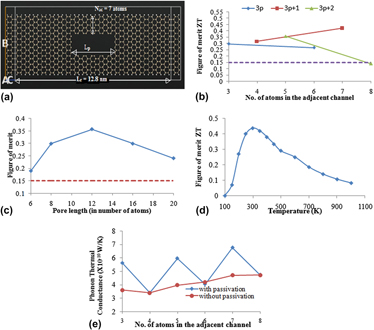Article contents
Theoretical investigation of effect of pore size and pore passivation on the thermoelectric performance of silicene nanoribbons
Published online by Cambridge University Press: 22 August 2017
Abstract

Persistent evolution and scaling down of integrating circuits have created a need to identify new thermoelectric materials that can be exploited to convert dissipated heat into electrical energy. We demonstrate that thermoelectric performance of silicene nanoribbons (SiNRs) can be enhanced by introducing nanopores We observe that with the incorporation of pores, thermal conductance of SiNRs is reduced which in turn leads to enhancement of thermoelectric performance (high ZT). Although the Seebeck coefficient degrades in the presence of pore, the conductivity exhibits an improved pattern, in effect contributing to better performance. In this paper, our aim is to tune the pore to its optimal dimension so as to enhance the overall thermoelectric efficiency and to study the effect of passivation at the pore edges on the thermoelectric parameters. It is further analyzed that with the pore passivation, the thermal conductance exhibits a width-dependent oscillating behavior. Ballistic transport regime and semi-empirical method using Huckel basis set are used to obtain the electrical properties, while the Tersoff potential is used for the phononic system.
- Type
- Articles
- Information
- Copyright
- Copyright © Materials Research Society 2017
Footnotes
Contributing Editor: Terry M. Tritt
References
REFERENCES
- 3
- Cited by





